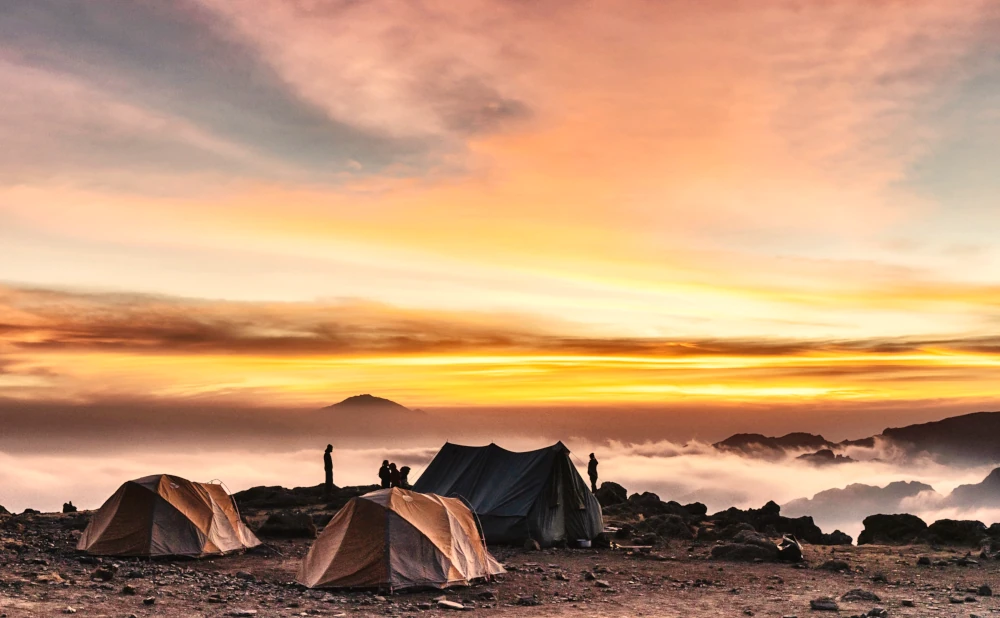
Conquer Mount Kilimanjaro via the challenging Umbwe route on a 6-day trekking adventure. Enjoy stunning landscapes and reach the summit in style.
When to Trek:
Best Time to Trek Mount Kilimanjaro:
Mount Kilimanjaro can be climbed year-round, but the best time to trek depends on weather conditions and the overall trekking experience. Below are the key considerations for each season to help you choose the best time:
1. Ideal Trekking Seasons (Dry Periods)
- January to March (Short Dry Season)
- Weather: Mild and clear skies, but cooler at higher altitudes.
- Advantages: Fewer crowds, great for scenic views, and suitable for photographers due to clear weather.
- Drawback: Slightly higher chances of encountering snow near the summit.
- June to October (Long Dry Season)
- Weather: Stable, dry, and sunny weather.
- Advantages: High visibility and the best summit success rates due to stable conditions.
- Drawback: This is the busiest season with more trekkers on the routes.
2. Less Recommended Periods (Rainy Seasons)
- April to May (Long Rainy Season)
- Weather: Heavy rains on the lower slopes and snow at higher altitudes.
- Challenges: Slippery trails, muddy paths, and poor visibility.
- Suitable for: Adventurous climbers willing to endure challenging weather.
- November to Early December (Short Rainy Season)
- Weather: Intermittent rains but less intense than April-May.
- Challenges: Trails can be muddy and slippery.
- Tip: The northern route (Rongai Route) is relatively drier during this period.
Additional Tips for Choosing the Best Time
- Summit Success: Dry seasons are ideal for first-timers seeking higher success rates.
- Photography: January-March and June-October provide clear skies for breathtaking shots.
- Wildlife Viewing: Combine the trek with Tanzania safaris during June-October for optimal wildlife experiences.
Preparations for Trekking Mount Kilimanjaro
To successfully trek Mount Kilimanjaro, thorough preparation is crucial to ensure a safe, enjoyable, and rewarding experience. Below is a comprehensive guide to help you get ready:
1. Physical Fitness Training
- Cardio Exercises: Engage in hiking, running, cycling, or swimming to build endurance.
- Strength Training: Focus on leg muscles, core, and upper body strength through squats, lunges, and weight training.
- Hiking Practice: Simulate trekking conditions by practicing on rugged terrain with a loaded backpack.
- Consistency: Start training at least 8-12 weeks before your trek.
2. Essential Gear Checklist
- Clothing:
- Moisture-wicking base layers
- Insulated mid-layers (fleece or down jackets)
- Waterproof outer layers (jacket and pants)
- Trekking pants and thermal leggings
- Warm hat, gloves, and buff or neck gaiter
- Footwear:
- Sturdy, waterproof hiking boots (well broken-in)
- Comfortable hiking socks (preferably merino wool)
- Accessories:
- Trekking poles (helpful for stability and reducing strain)
- Sunglasses with UV protection
- Headlamp with extra batteries
- Backpack (20-30L for daily essentials)
- Sleeping bag rated for -10°C to -15°C
3. Health and Safety Preparations
- Acclimatization: Choose a longer trekking route (7-9 days) to reduce the risk of altitude sickness.
- Vaccinations: Check with your doctor for recommended vaccinations (Yellow fever may be required).
- Medication: Carry altitude sickness medication (e.g., Diamox), painkillers, and personal prescriptions.
- Hydration: Drink 3-4 liters of water daily during the trek.
- Travel Insurance: Ensure it covers high-altitude trekking and emergency evacuation.
4. Mental Preparation
- Positive Mindset: Prepare for mental challenges due to physical fatigue and changing weather conditions.
- Pace Yourself: Hike at a steady, manageable pace—Kilimanjaro guides often say “Pole Pole,” meaning “slowly, slowly.”
- Focus on the Journey: Appreciate the stunning landscapes rather than just aiming for the summit.
5. Documentation and Logistics
- Permits and Fees: Ensure your tour company handles park permits and fees.
- Passport and Visa: Ensure your passport is valid, and obtain a Tanzanian visa if required.
- Flight and Transfer Arrangements: Book flights to Kilimanjaro International Airport and confirm transfers to the trailhead.
6. Choosing a Reliable Tour Company
- Experience: Look for companies with experienced guides certified in first aid and high-altitude trekking.
- Safari 56 Advantage: Our expert team offers well-organized trekking packages, experienced guides, and personalized support to help you summit safely and confidently.
Explore More: Related Safari & Adventure Itineraries